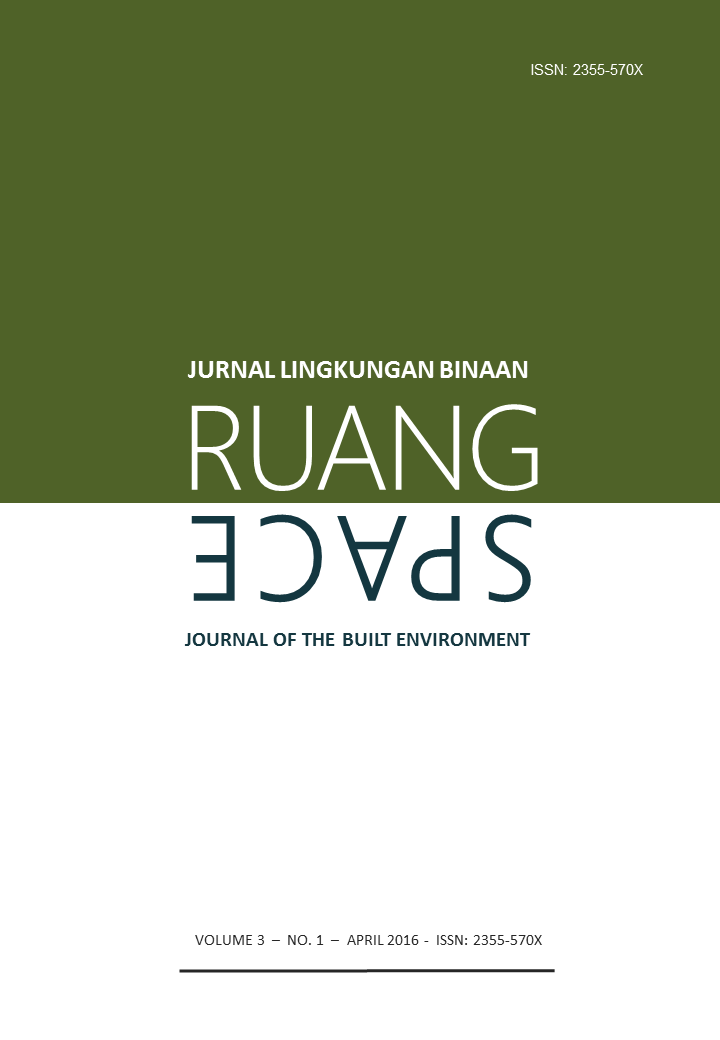PERKEMBANGAN KERUANGAN DI KORIDOR BYPASS BIL-BATUJAI PASCA PEMBANGUNAN BANDARA INTERNASIONAL LOMBOK
Abstract
Abstract
Lombok International Airport (BIL) was located in Central Lombok and was built in 2008. Its efficiency was supported by the construction of the BIL-Batujai bypass - part of BIL-Gerung bypass - in the same year. In anticipating the many forms of uncontrolled development that were likely to take place along this bypass upon its completion, Central Lombok local government had instigated a Detailed Spatial Plan (RDTR) for BIL and its surroundings in 2006. This article therefore has two objectives. First, by investigating those factors determining various forms of land use change occurring along the BIL-Batujai corridor; and second by investigating the conformance of these developments to the 2006's RDTR of Central Lombok. In doing so, this study uses a qualitative approach. Study findings show there are two types of developments including both physical and non-physical. The physical developments cover the construction of both permanent and non-permanent structures, the modification of homes into store-houses, the eviction of many buildings used for art-shops, the failed attempt to relocate Penujak market, and the success story of Batujai settlement relocation. Non-physical development embraces phenomenon such as, changes in the image of Batujai-BIL bypass corridor, the increase in land prices, and the change in the occupations of community members living in proximity to this bypass. This study concludes by suggesting that determining factors underlining these developments are as follows: (1) the emergence of new functions and activities brought by the operation of Lombok International Airport (BIL); (2) accessibility; (3) the topography of BIL-Batujai corridor which is relatively flat and served with adequate infrastructures; (4) the existence of local government spatial planning policies that regulate development of the BIL and its surroundings areas; (5) a tendency of the existing land owners to transfer rights over land to other party/s for economic reasons; (6) the development of housing units initiated by developers in response to a rising need for homes close by the airport; (7) the late response of the local government in controlling rapid spatial developments; and (8) problems associated with the economic rationale behind many forms of development.
Keywords: Lombok International Airport (BIL), BIL-Batujaibypass corridor, spatial development
Abstrak
Bandara Internasional Lombok (BIL) adalah bandara baru bertaraf internasional yang dibangun pada tahun 2008 dan berlokasi di Kabupaten Lombok Tengah. Pembangunan bypass BIL-Batujai yang merupakan bagian dari bypass BIL-Gerung adalah prasarana yang dibangun pada tahun 2008 untuk mendukung aktivitas BIL. Pasca pembangunan bypass tersebut, terjadi perkembangan keruangan di koridor tersebut. Dalam mengendalikan perkembangan yang terjadi, pemerintah setempat telah membuat RDTR Kawasan Bandara Lombok Baru (2006). Artikel ini ditulis berdasarkan studi yang bertujuan untuk mengetahui fenomena perkembangan keruangan yang terjadi dan menganalisis faktor-faktor penyebab terjadinya perkembangan di koridor tersebut, serta menganalisis kesesuaian perkembangan yang terjadi dengan arahan dalam RDTR. Guna mendukung penelitian, digunakan pendekatan kualitatif dengan paradigma fenomenologi. Hasil penelitian menunjukkan bahwa fenomena perkembangan keruangan yang terjadi meliputi aspek fisikal dan non-fisikal. Aspek fisikal meliputi: adanya pembangunan baru baik permanen maupun non-permanen, penambahan fungsi bangunan rumah menjadi toko, hilangnya fungsi bangunan artshop, fenomena gagalnya penggusuran pasar di Penujak dan berhasilnya penggusuran rumah diBatujai, hingga gejala perpindahan keramaian yang terjadi. Aspek non-fisikal meliputi: berubahnya image koridor bypass BIL-Batujai, peningkatan harga lahan, serta berubahnya profesi masyarakat. Faktor-faktor penyebab perkembangan meliputi: (1) aktivitas BIL dan wilayah sekitarnya; (2) aksesibilitas; (3) karakteristik lahan bertopografi datar dengan utilitas yang baik; (4) peraturan penggunaan lahan dalam RTRW Kabupaten Lombok Tengah dan RDTR Kawasan Bandara Lombok Baru; (5) karakteristik pemilik lahan berstatus ekonomi lemah sehingga cenderung untuk menjual lahannya; (6) prakarsa pengembang perumahan yang berperan dalam perkembangan keruangan; (7) kurang antisipatifnya pemerintah terhadap perkembangan yang terjadi; dan (8) permasalahan keruangan berlatar motif ekonomi.
Kata kunci: perkembangan, keruangan, koridor, BILDownloads
Keywords
The copyright of the received article shall be assigned to the journal as the publisher of the journal. The intended copyright includes the right to publish the article in various forms (including reprints). The journal maintains the publishing rights to the published articles.



